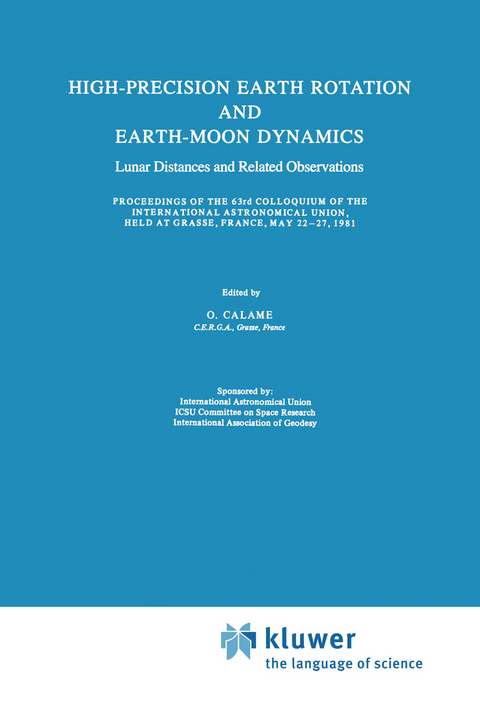
High-Precision Earth Rotation and Earth-Moon Dynamics
Springer (Verlag)
978-94-009-7809-6 (ISBN)
Depuis le 21 Juillet 1969 une ere nouvelle s'est ouverte dans 3 notre connaissance du systeme Terre-Lune avec l'accu. mulation de mesures 3 de distances ultra-precises aux reflecteurs laser deposes sur la surface lunaire. Au cours des recherches effectuees a partir de cette nouvelle technique il s'est tres vite avere que le champ d'applications etait 3 considerable et qu'il fallait completement reviser certaines theories anterieures. Avec des observations au niveau de quelques centimetres 3 il n'est plus possible d'etudier des phenomenes isolement et3 quel que soit le pole d'interet fixe il est necessaire aussi d'etudier 3 conjointement les autres aspects du systeme. Tres vite3 il est alors apparu que les recherches potentielles relatives a ce type d'observa- tions ne se bornaient pas seulement aux applications lunaires mais pouvaient recouvrir un domaine plus vaste en Astronomie Geodesie 3 3 Geophysique Cosmologie etc ...C'est ainsi qu'est ne le programme 3 3 international EROLD avec comme but plus specifique l'etude de la 3 rotation terrestre mais avec des aspects connexes lies en particulier 3 a la dynamique du systeme Terre-Lune dans son ensemble.
Il etait alors naturel de faire le bilan a un niveau eleve de ces annees de recher- 3 3 ches dans cette nouvelle phase de la connaissance. Par ailleurs d)autres types de techniques modernes ont egale- 3 ment vu le jour durant cette derniere decennie avec entre autres 3 applications la determination de la rotation de la Terre.
I.- Combination of Earth rotation parameters obtained in 1980 by various techniques.- Optical observations of Time and Latitude and the determining of the Earth’s rotation parameters in 1980.- Rotation of the Earth from Lunar Laser Ranging.- Earth rotation from a simultaneous reduction of LLR and LAGEOS laser ranging data.- Earth rotation in the EROLD framework.- Intercomparison of Lunar Laser and traditional determinations of Earth rotation.- An intercomparison of Connected-Element Interferometer and Lunar Laser Earth rotation parameters.- Earth rotation information derived from MERIT and POLARIS VLBI observations.- Polar motion and Earth rotation from LAGEOS Laser ranging.- Comparison of polar motion results using Lunar Laser Ranging.- The pole position in October 1980 as determined from LAGEOS laser data.- Comparison of polar motion data from the 1980 project MERIT short campaign.- Progress report on project MERIT.- General Discussion.- II.- Dependence of the lunisolar perturbations in the Earth rotation on the adopted Earth model.- Atmospheric angular momentum and the length of day.- Earth’s rotation and polar motion based on Global Positioning System satellite data.- Activities of astro-geodynamics research in China.- III.- Dissipation in the Moon : A review of the experimental evidence and physical implications.- Planetary and Earth figure perturbations in the librations of the Moon.- Modelling the effect of Earth tides in the lunar orbital motion.- Is the gravitational constant changing ?.- Results from Lunar Laser Ranging data analysis.- The relativistic planetary perturbations and the orbital motion of the Moon.- Analytical theories of the motion of the Moon.- Numerical studies of the lunar orbit at CERGA.- Comparison of lunar ephemerides (SALE and ELP)with numerical integration.- Comparison of ELP-2000 to a JPL numerical integration.- Note about a new evaluation of the direct perturbations of the planets on the Moon’s motion.- IV.- Relations between celestial and selenocentric reference frames.- On the absolute orientation of the selenodetic reference frame.- On the accuracy of the 1980 IAU nutation series.- Comments on the effect of adopting new precession and equinox corrections.- Determination of coordinates for the Orroral lunar ranging station.- Biases in pole position computed from data from different Navy Navigation satellites.- VLBI measurements of radio source positions at three U.S. stations.- Expansion of the disturbing function by factorization.- General discussion.- Adopted resolution.- Index of subjects and names.
| Reihe/Serie | Astrophysics and Space Science Library ; 94 |
|---|---|
| Zusatzinfo | XX, 354 p. |
| Verlagsort | Dordrecht |
| Sprache | englisch |
| Maße | 160 x 240 mm |
| Themenwelt | Naturwissenschaften ► Physik / Astronomie ► Astronomie / Astrophysik |
| ISBN-10 | 94-009-7809-X / 940097809X |
| ISBN-13 | 978-94-009-7809-6 / 9789400978096 |
| Zustand | Neuware |
| Haben Sie eine Frage zum Produkt? |
aus dem Bereich


